#Epigonus
Text
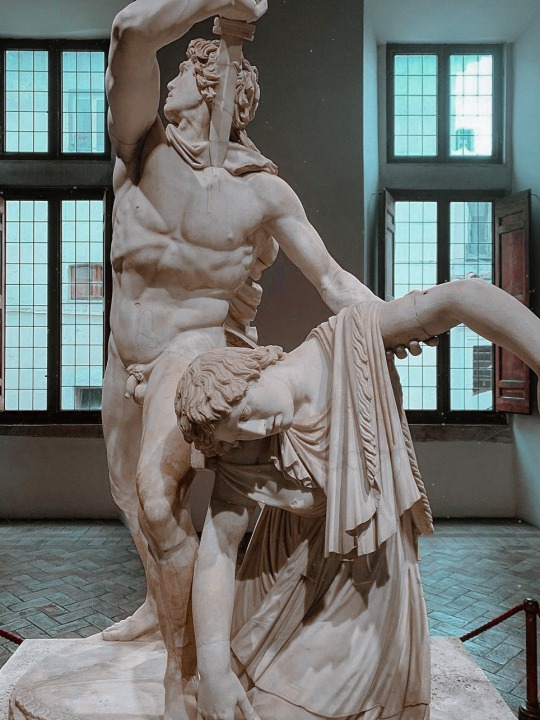

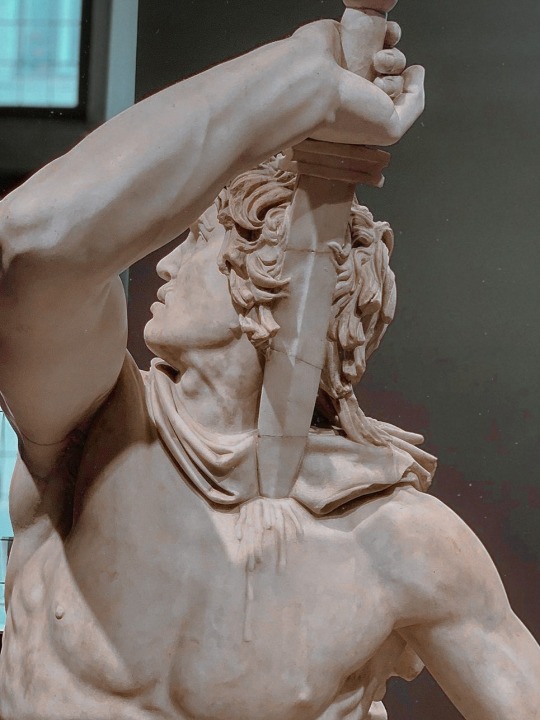

Ludovisi Gaul by Epigonus.
ig credit: charles.amsterdam.stpetersburg.
#sculptural#sculptor#sculpture#Epigonus#helenism#hellenistic#alternative#aesthetic#dark academia#dark academic aesthetic#dark aesthetic#aestheitcs#dark#art#light acadamia aesthetic#light academia
632 notes
·
View notes
Text
fucking Gift Mendi ex girlfriend
Sex Therapy With StepAunt Trinity St Clair
Bellesa Films - Private Session
Sweetie welcomes lewd neighbor to drill her in hardcore
She gives him a blowjob and then he fucks her hard and cums hard on her face
Sexy Farm Girls Share A Cock
Nalgas morenas gay
Massage Therapy of Needles, Legs and Lower Back ASMR
brisbane casino development
Sexy virgin Zenya Lai plays with her pussy before sucking and taking cock for first time
#baronizing#traducer#Lobale#pingu#hypermotile#pinfish#Nyctea#world-sated#mortarless#coyishness#Cotys#metamorphisms#Dinan#astrologically#monkeys#tracklessly#Epigonus#bepimple#re-estimate#untrance
0 notes
Text

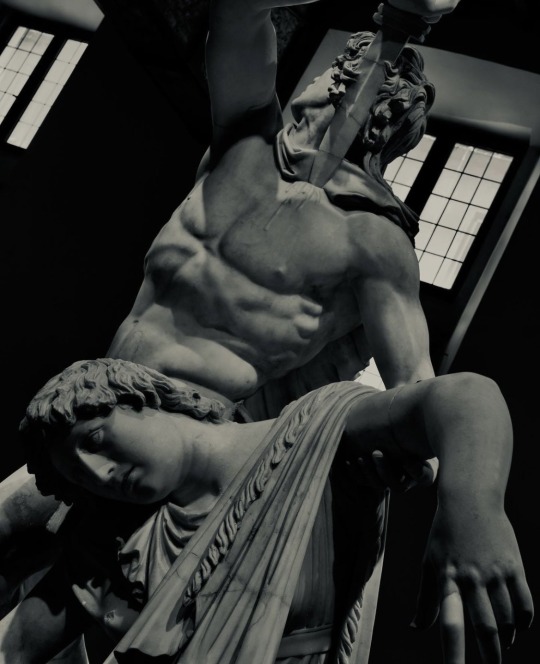



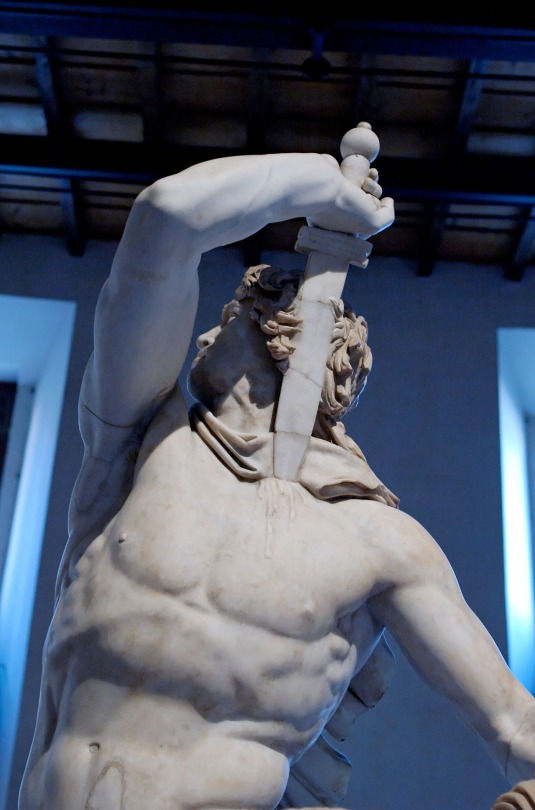


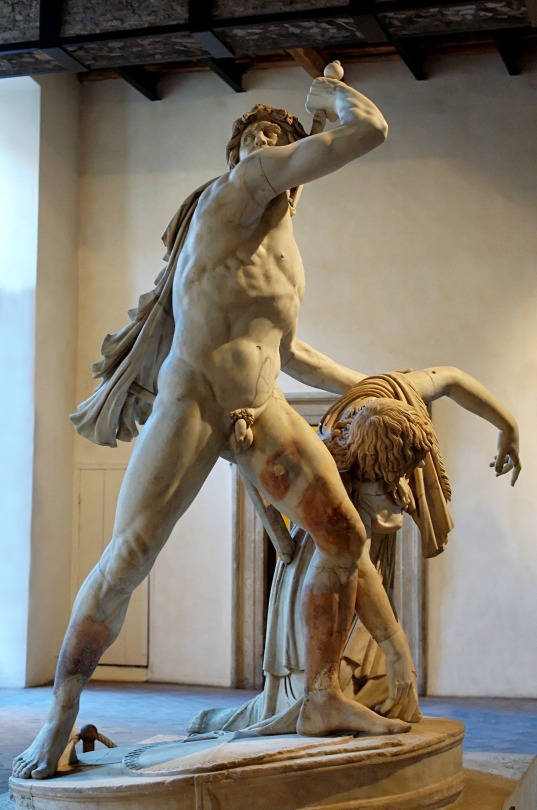
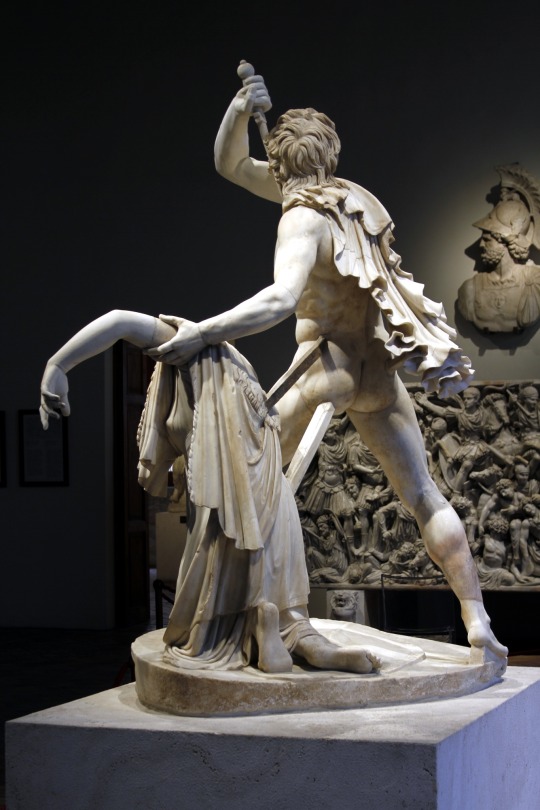
The Galata Ludovisi or suicidal Galata, is a sculptural group that shows the moment in which the central character is about to commit suicide after having killed his wife. The sculpture was made (along with 6 other sculptures) by decision of King Attalus I (King of Pergamon 269-197 BC) to commemorate his victory over the Galatians in 233 BC. It is possibly a Roman copy of the s. I BC in marble of a Greek bronze statue that has now disappeared. It is dated between 230-220 BC. and its author could be Epigonus. The work can be seen in the National Roman Museum of the Altemps Palace, Rome
185 notes
·
View notes
Text

Galata Suicida
The second statue we have of the donary of Attalus I commissioned is the Galata suicida (suicidal celts, or celts with his wife).
Here Epigonus built an image of the vanquished without compassion, objectively describing their character and illustrating the degeneration of courage that turns into fury and leads to prefer suicide to imprisonment.
In "Galata suicida con la moglie" the artist illustrates the decision of a leader to give death to himself and his bride. The warrior, naked, sticks his sword in his chest dramatically turning his gaze upwards, with an expression that is both concentrated and determined, while dropping the body of his dying wife. The position of the two figures is skillfully calculated, so as to suggest an almost rotary movement culminating in the arm raised with the sword. The Celtic identity of the character is suggested by physiognomic and costume details, such as the mustache and thick hair, rendered by means of compact locks because the roosters, before the battle, bathed them with water and chalk; to the Celtic habits also belonged the naked fighting and the presence of women on the battlefield to incite men.
The Galata suicida, also known as Galata Ludovisi, is also a Roman marble copy, dating back to the first century BC, of the Greek original that together with the dying Galata was part of the donary complex. The statue is now kept at the National Roman Museum of Palazzo Altemps in Rome. The suicidal Galata was found, together with the previous one, during the excavations of Villa Ludovisi. At a criminological analysis the work shows a warrior that the marble crystallizes in the act of committing suicide, sticking a short sword, very similar to the Roman gladius, between the collarbones.
The warrior is well supported by the legs spread apart which, together with the torso, are stretched to the right, while the head is proudly turned backwards, perhaps ideally facing the battlefield that sanctioned the defeat of his people. The naked body, covered only on the back by a cloak that follows the movement of the Galata with its deeply realistic folds, shows the warrior's musculature, carefully carved down to the smallest anatomical details. The companion is abandoned on her knees, now one step away from death. The sculpture is strongly evocative, revealing unequivocal sensations of heroism and honor, to emotionally highlight the value of the vanquished and therefore, consequently, also that of the winners. Probably the figure was at the center of the donario, conceived to be appreciated from multiple points of view, ideally monopolizing the space that surrounds it. The suicidal Galata represents, together with the dying Galata, one of the greatest examples of classical sculpture, which in addition to cheering the eye for its incontrovertible and deeply realistic beauty gives us the photograph of a valiant people that history has swept away but that marble has returned to us after centuries.
#art#art academia#dark academia#art history#light academia#academia#chaotic academia#classic academia#statue#galata suicida#roman art#ancient rome#ancient art
3 notes
·
View notes
Text
Artist Research:
Ludovisi Gaul is a sculpture by Epigonus of Pergamum
Ludovisi Gaul (sometimes called "The Galatian Suicide") is an ancient Roman statue of a Gallic man plunging a sword into his chest as he holds the dying body of his wife whom he murdered. This sculpture is a marble copy of a now-lost Greek bronze original. Gaul Ludovisi is at Palazzo Altemps in Rome. This statue is unique for its time because it was common to represent the winner but the Gaul Ludovisi rather represents the loser. I found this sculpture profound and relevant to my temporary project as it depicts how a helpless woman's life is thrown off of its trajectory because of a man's choice or opinion. This man chooses to take his wife's life based on her own whims and perception of honour.
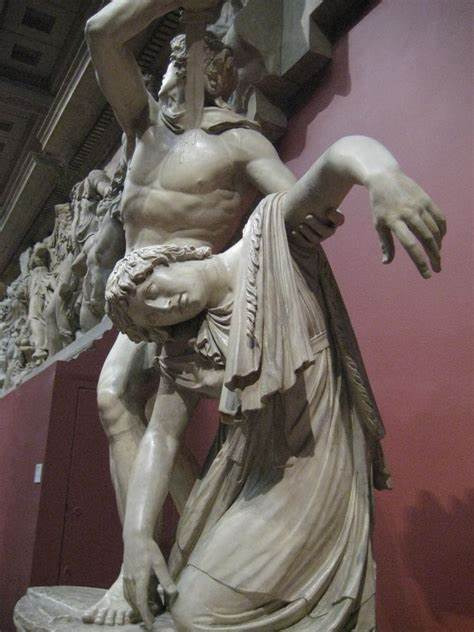

2 notes
·
View notes
Text
FAUNE
Hae duae provinciae bello quondam piratico catervis mixtae praedonum a Servilio pro consule missae sub iugum factae sunt vectigales. et hae quidem regiones velut in prominenti terrarum lingua positae ob orbe eoo monte Amano disparantur.
Ex turba vero imae sortis et paupertinae in tabernis aliqui pernoctant vinariis, non nulli velariis umbraculorum theatralium latent, quae Campanam imitatus lasciviam Catulus in aedilitate sua suspendit omnium primus; aut pugnaciter aleis certant turpi sono fragosis naribus introrsum reducto spiritu concrepantes; aut quod est studiorum omnium maximum ab ortu lucis ad vesperam sole fatiscunt vel pluviis, per minutias aurigarum equorumque praecipua vel delicta scrutantes.
Et eodem impetu Domitianum praecipitem per scalas itidem funibus constrinxerunt, eosque coniunctos per ampla spatia civitatis acri raptavere discursu. iamque artuum et membrorum divulsa conpage superscandentes corpora mortuorum ad ultimam truncata deformitatem velut exsaturati mox abiecerunt in flumen.
Haec ubi latius fama vulgasset missaeque relationes adsiduae Gallum Caesarem permovissent, quoniam magister equitum longius ea tempestate distinebatur, iussus comes orientis Nebridius contractis undique militaribus copiis ad eximendam periculo civitatem amplam et oportunam studio properabat ingenti, quo cognito abscessere latrones nulla re amplius memorabili gesta, dispersique ut solent avia montium petiere celsorum.
Et quia Montius inter dilancinantium manus spiritum efflaturus Epigonum et Eusebium nec professionem nec dignitatem ostendens aliquotiens increpabat, qui sint hi magna quaerebatur industria, et nequid intepesceret, Epigonus e Lycia philosophus ducitur et Eusebius ab Emissa Pittacas cognomento, concitatus orator, cum quaestor non hos sed tribunos fabricarum insimulasset promittentes armorum si novas res agitari conperissent.
Ergo ego senator inimicus, si ita vultis, homini, amicus esse, sicut semper fui, rei publicae debeo. Quid? si ipsas inimicitias, depono rei publicae causa, quis me tandem iure reprehendet, praesertim cum ego omnium meorum consiliorum atque factorum exempla semper ex summorum hominum consiliis atque factis mihi censuerim petenda.
Sed si ille hac tam eximia fortuna propter utilitatem rei publicae frui non properat, ut omnia illa conficiat, quid ego, senator, facere debeo, quem, etiamsi ille aliud vellet, rei publicae consulere oporteret?
Haec igitur lex in amicitia sanciatur, ut neque rogemus res turpes nec faciamus rogati. Turpis enim excusatio est et minime accipienda cum in ceteris peccatis, tum si quis contra rem publicam se amici causa fecisse fateatur. Etenim eo loco, Fanni et Scaevola, locati sumus ut nos longe prospicere oporteat futuros casus rei publicae. Deflexit iam aliquantum de spatio curriculoque consuetudo maiorum.
Itaque tum Scaevola cum in eam ipsam mentionem incidisset, exposuit nobis sermonem Laeli de amicitia habitum ab illo secum et cum altero genero, C. Fannio Marci filio, paucis diebus post mortem Africani. Eius disputationis sententias memoriae mandavi, quas hoc libro exposui arbitratu meo; quasi enim ipsos induxi loquentes, ne 'inquam' et 'inquit' saepius interponeretur, atque ut tamquam a praesentibus coram haberi sermo videretur.
Accenderat super his incitatum propositum ad nocendum aliqua mulier vilis, quae ad palatium ut poposcerat intromissa insidias ei latenter obtendi prodiderat a militibus obscurissimis. quam Constantina exultans ut in tuto iam locata mariti salute muneratam vehiculoque inpositam per regiae ianuas emisit in publicum, ut his inlecebris alios
Hae duae provinciae bello quondam piratico catervis mixtae praedonum a Servilio pro consule missae sub iugum factae sunt vectigales. et hae quidem regiones velut in prominenti terrarum lingua positae ob orbe eoo monte Amano disparantur.
Ex turba vero imae sortis et paupertinae in tabernis aliqui pernoctant vinariis, non nulli velariis umbraculorum theatralium latent, quae Campanam imitatus lasciviam Catulus in aedilitate sua suspendit omnium primus; aut pugnaciter aleis certant turpi sono fragosis naribus introrsum reducto spiritu concrepantes; aut quod est studiorum omnium maximum ab ortu lucis ad vesperam sole fatiscunt vel pluviis, per minutias aurigarum equorumque praecipua vel delicta scrutantes.
Et eodem impetu Domitianum praecipitem per scalas itidem funibus constrinxerunt, eosque coniunctos per ampla spatia civitatis acri raptavere discursu. iamque artuum et membrorum divulsa conpage superscandentes corpora mortuorum ad ultimam truncata deformitatem velut exsaturati mox abiecerunt in flumen.
Haec ubi latius fama vulgasset missaeque relationes adsiduae Gallum Caesarem permovissent, quoniam magister equitum longius ea tempestate distinebatur, iussus comes orientis Nebridius contractis undique militaribus copiis ad eximendam periculo civitatem amplam et oportunam studio properabat ingenti, quo cognito abscessere latrones nulla re amplius memorabili gesta, dispersique ut solent avia montium petiere celsorum.
Et quia Montius inter dilancinantium manus spiritum efflaturus Epigonum et Eusebium nec professionem nec dignitatem ostendens aliquotiens increpabat, qui sint hi magna quaerebatur industria, et nequid intepesceret, Epigonus e Lycia philosophus ducitur et Eusebius ab Emissa Pittacas cognomento, concitatus orator, cum quaestor non hos sed tribunos fabricarum insimulasset promittentes armorum si novas res agitari conperissent.
Ergo ego senator inimicus, si ita vultis, homini, amicus esse, sicut semper fui, rei publicae debeo. Quid? si ipsas inimicitias, depono rei publicae causa, quis me tandem iure reprehendet, praesertim cum ego omnium meorum consiliorum atque factorum exempla semper ex summorum hominum consiliis atque factis mihi censuerim petenda.
Sed si ille hac tam eximia fortuna propter utilitatem rei publicae frui non properat, ut omnia illa conficiat, quid ego, senator, facere debeo, quem, etiamsi ille aliud vellet, rei publicae consulere oporteret?
Haec igitur lex in amicitia sanciatur, ut neque rogemus res turpes nec faciamus rogati. Turpis enim excusatio est et minime accipienda cum in ceteris peccatis, tum si quis contra rem publicam se amici causa fecisse fateatur. Etenim eo loco, Fanni et Scaevola, locati sumus ut nos longe prospicere oporteat futuros casus rei publicae. Deflexit iam aliquantum de spatio curriculoque consuetudo maiorum.
Itaque tum Scaevola cum in eam ipsam mentionem incidisset, exposuit nobis sermonem Laeli de amicitia habitum ab illo secum et cum altero genero, C. Fannio Marci filio, paucis diebus post mortem Africani. Eius disputationis sententias memoriae mandavi, quas hoc libro exposui arbitratu meo; quasi enim ipsos induxi loquentes, ne 'inquam' et 'inquit' saepius interponeretur, atque ut tamquam a praesentibus coram haberi sermo videretur.
Accenderat super his incitatum propositum ad nocendum aliqua mulier vilis, quae ad palatium ut poposcerat intromissa insidias ei latenter obtendi prodiderat a militibus obscurissimis. quam Constantina exultans ut in tuto iam locata mariti salute muneratam vehiculoque inpositam per regiae ianuas emisit in publicum, ut his inlecebris alios
0 notes
Photo



The Dying Gaul, Roman marble copy of a now lost sculpture from the Hellenistic period (323-31 BC) thought to have been made in bronze. The original may have been commissioned at some time between 230 and 220 BC by Attalus I of Pergamon to celebrate his victory over the Galatians, the Celtic or Gaulish people of parts of Anatolia (modern Turkey). The original sculptor is believed to have been Epigonus, a court sculptor of the Attalid dynasty of Pergamon.Until the 20th century the marble statue was usually known as The Dying Gladiator, on the assumption that it depicted a wounded gladiator in a Roman amphitheatre. However in the mid-19th century it was re-identified as a Gaul or Galatian and the present name "Dying Gaul" gradually achieved popular acceptance. The warrior is represented with characteristic Celtic hairstyle and moustache with a Celtic torc around his neck. x
87 notes
·
View notes
Photo
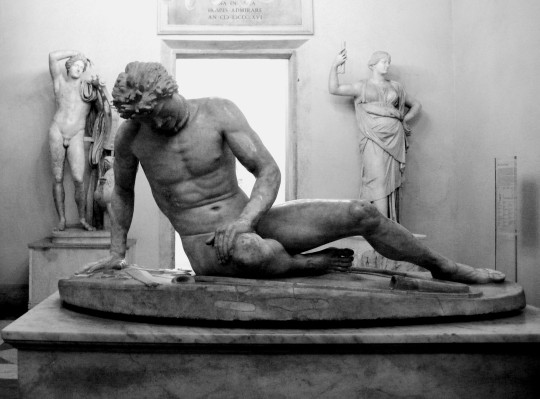
Ölen Galya
Ölen Galya, Capitoline müzesindeki en tanınmış ve en önemli eserlerden biridir. I. Attalus'un MÖ 3. ve 2. yüzyıllarda Galatlara karşı kazandığı zaferleri anmak için Pergamon'a adadığı eski voto grubundaki heykellerden birinin kopyasıdır. Orijinal heykeltıraşın kimliği bilinmemekle birlikte, Pergamon Attalid hanedanının saray heykeltıraşı Epigonus'un heykeltıraş olabileceği öne sürüldü.
Heykel, özellikle yüzünde dikkate değer bir gerçekçilikle ölmekte olan bir Kelt'i tasvir ediyor ve boyanmış olabilir. Tipik bir Galya saç stili ve bıyığı olan bir Galya savaşçısı olarak temsil edilir. Figür, boyun torku dışında çıplak. Kılıcı ve diğer nesneleri yanında dururken düşmüş kalkanının üzerinde yatar. Heykel, hem Keltlerin yenilgisinin bir hatırlatıcısı, hem de onları mağlup eden insanların gücünü göstermekte hem de değerli düşmanları olarak cesaretlerinin bir anısına hizmet ediyor.
Mermer, 93cm
Horti Sallustiani, Capitoline Müzesi, Roma.
EN
The Dying Gaul
The Dying Gaul is one of the best-known and most important works in the Capitoline museum. It is a replica of one of the sculptures in the ex-voto group dedicated to Pergamon by Attalus I to commemorate the victories over the Galatians in the 3rd and 2nd centuries BC. The identity of the sculptor of the original is unknown, but it has been suggested that Epigonus, the court sculptor of the Attalid dynasty of Pergamon, may have been its sculptor.
The statue depicts a dying Celt with remarkable realism, particularly in the face, and may have been painted. He is represented as a Gallic warrior with a typically Gallic hairstyle and moustache. The figure is naked save for a neck torc. He lies on his fallen shield while his sword and other objects lie beside him. The statue serves both as a reminder of the Celts' defeat, thus demonstrating the might of the people who defeated them, and a memorial to their bravery as worthy adversaries.
Marble, 93cm
Horti Sallustiani, Capitoline Museum, Rome.
27 notes
·
View notes
Text
The Grapevine’s Lament
Anthologia Palatina 9.261 = Epigonos of Thessalonica (1st cent. BCE?)
I, the vine, once enjoyed a youth
Full of vine-blossoms blooming finely,
And brought forth grapes in long-stretched clusters.
But now I am growing old, as you see.
Behold how time subdues us all!
Even the cluster of grapes must feel
The wrinkled furrows of old age.
Ἡ πάρος εὐπετάλοισιν ἐν οἰνάνθαις νεάσασα
καὶ τετανῶν βοτρύων ῥᾶγα κομισσαμένη
νῦν οὕτω γραιοῦμαι. ἴδ’, ὁ χρόνος οἷα δαμάζει·
καὶ σταφυλὴ γήρως αἰσθάνεται ῥυτίδων.

Still Life of Grapes and a Peach on a Table-top, follower of Jan van Huysum, prob. 19th century
#classics#tagamemnon#Ancient Greek#Ancient Greece#poem#poetry#translation#Hellenistic period#epigram#Epigonus of Thessalonica#Palatine Anthology#Anthologia Palatina#Jan van Huysum
91 notes
·
View notes
Photo

Saints Pontian and Hippolytus - Feast Day: August 13th - Ordinary Time
St. Pontian, pope and martyr
Dates of birth and death unknown.
With Pontian begins the brief chronicle of the Roman bishops of the third century, of which the author of the Liberian Catalogue of the popes made use in the fourth century and which gives more exact data for the lives of the popes.
According to this account Pontian was made pope July 21, 230, and reigned until 235.
In 235 in the reign of Maximinus the Thracian began a persecution directed chiefly against the heads of the Church. One of its first victims was Pontian, who with Hippolytus was banished to the unhealthy island of Sardinia. To make the election of a new pope possible, Pontian resigned September 28, 235.
Hippolytus (Note: feast is also celebrated in Latin Calendar along with St. Cassian), who had been banished with Pontian, became reconciled to the Roman Church, and with this the schism he had caused came to an end. How much longer Pontian endured the sufferings of exile and harsh treatment in the Sardinian mines is unknown. According to old and no longer existing Acts of martyrs, used by the author of the "Liber Pontificalis", he died in consequence of the privations and inhuman treatment he had to bear.
Pope Fabian (236-50) had the remains of Pontian and Hippolytus brought to Rome at a later date and Pontian was buried on August 13 in the papal crypt of the Catacomb of Callistus. In 1909 the original epitaph was found in the crypt of St. Cecilia, near the papal crypt. The epitaph, agreeing with the other known epitaphs of the papal crypt, reads: PONTIANOS, EPISK. MARTUR (Pontianus, Bishop, Martyr). The word mártur was added later and is written in ligature [cf. Wilpert, "Die Papstgräber und die Cäciliengruft in der Katakombe des hl. Kalixtus" (Freiburg, 1909), 1 sq., 17 sq., Plate III]. He is placed under August 13 in the list of the "Depositiones martyrum" in the chronographia of 354.
St. Hippolytus, priest and martyr
Martyr, presbyter and antipope; date of birth unknown; died about 236. Until the publication in 1851 of the recently discovered "Philosophumena", it was impossible to obtain any definite authentic facts concerning Hippolytus of Rome.
The discovery of the "Philosophumean" has now made it possible to clear up the most important period of the life of St. Hippolytus through his own evidence, and at the same time to test and correct the conflicting accounts contained in the old authorities. We proceed on the assumption that Hippolytus was really the author of the aforesaid work, an hypothesis almost universally accepted by investigators today.
Hippolytus was a presbyter of the Church of Rome at the beginning of the third century. There is no difficulty in admitting that he could have been a disciple of St Irenaeus either in Rome or Lyons. It is equally possible that Origen heard a homily by Hippolytus when he went to Rome about the year 212. In the reign of Pope Zephyrinus (198-217) he came into conflict with that pontiff and with the majority of the Church of Rome, primarily on account of the christological opinions which for some time had been causing controversies in Rome. Hippolytus had combated the heresy of Theodotion and the Alogi; in like fashion he opposed the false doctrines of Noetus, of Epigonus, of Cleomenes, and of Sabellius, who emphasized the unity of God too one -sidedly (Monarchians) and saw in the concepts of the Father and the Son merely manifestations (modi) of the Divine Nature (Modalism, Sabellianism). Hippolytus, on the contrary, stood uncompromisingly for a real difference between the Son (Logos) and the Father, but so as to represent the Former as a Divine Person almost completely separate from God (Ditheism) and at the same time altogether subordinate to the Father (Subordinationism). As the heresy in the doctrine of the Modalists was not at first clearly apparent, Pope Zephyrinus declined to give a decision. For this Hippolytus gravely censured him, representing him as an incompetent man, unworthy to rule the Church of Rome and as a tool in the hands of the ambitious and intriguing deacon Callistus, whose early life is maliciously depicted (Philosophumena, IX, xi-xii). Consequently when Callistus was elected pope (217-218) on the death of Zephyrinus, Hippolytus immediately left the communion of the Roman Church and had himself elected antipope by his small band of followers. These he calls the Catholic Church and himself successor to the Apostles, terming the great majority of Roman Christians the School of Callistus. He accuses Callistus of having fallen first into the heresy of Theodotus, then into that of Sabellius; also of having through avarice degraded ecclesiastical, and especially the penitential, discipline to a disgraceful laxity. These reproaches were altogether unjustified. Hippolytus himself advocated an excessive rigorism. He continued in opposition as antipope throughout the reigns of the two immediate successors of Callistus, Urban (222 or 223 to 230) and Pontius (230 -35), and during this period, probably during the pontificate of Pontianus, he wrote the "Philosophumena". He was banished to the unhealthful island (insula nociva) of Sardinia at the same time as Pontianus; and shortly before this, or soon afterward, he became reconciled with the legitimate bishop and the Church of Rome. For, after both exiles had died on the island of Sardinia, their mortal remains were brought back to Rome on the same day, August 13 (either 236 or one of the following years), and solemnly interred, Pontianus in the papal vault in the catacomb of Callistus and Hippolytus in a spot on the Via Tiburtina. Both were equally revered as martyrs by the Roman Church: certain proof that Hippolytus had made his peace with that Church before his death. With his death the schism must have come to a speedy end, which accounts for its identification with the Novatian schism at the end of the fourth century, as we learn from the inscription by Damasus.
Image is of Saints Pontian and Hippolytus
7 notes
·
View notes
Text


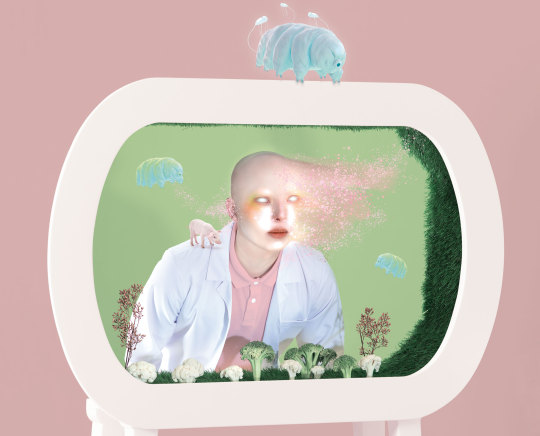

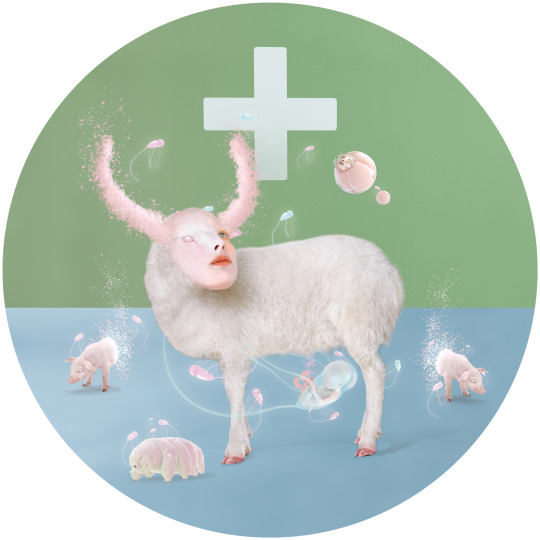


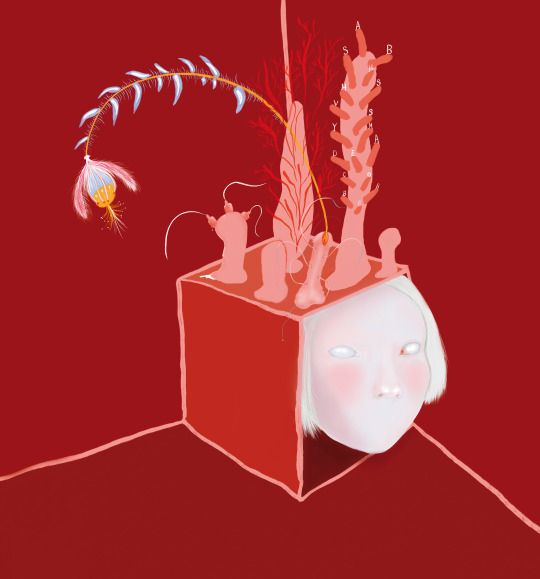

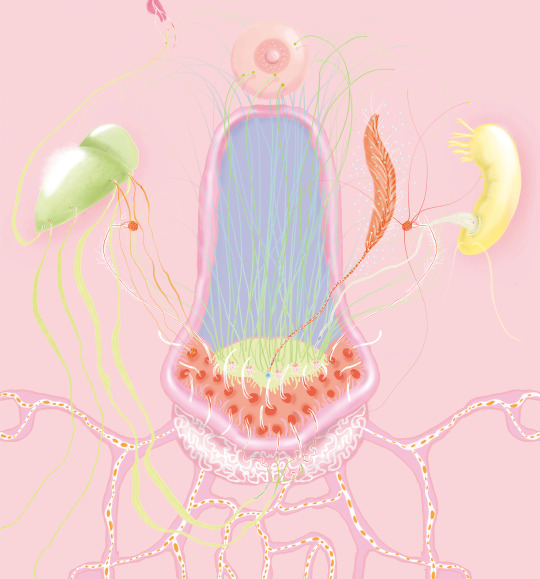
B O T A N I C H O S P I T A L
he characters, working in a Botanic Hospital consistingof a simulation, may in time go into an irregular condition with lame images belonging to the memory inthis area they use as a host.Nothing proceeds properly in the images available,created by the data which artificial intelligence and memory receive from each other. It is in question that simulation area visualizes itself with these errors through the references taken from realism. Because memory never follows a linear path while it reaches memories. On the contrary, it is nourished with the past,future and present all at the same time. Even though the word “memory” is indicated as specific memories belonging to the past, it continuously depicts and imagines future.Whereever we are, the first thing we will do is to utilizeour memory against any situation according to Karakaş.Man is memory and nothing else!The existing figures, in the series in which archaic structure helps memory, does not extend beyond beingan epigon of the present reality in the simulation area.Because epigon needs memory! The memory of the gene…Our reason for being, in a weird way, is built upon searching for meaning, although the only thing necessary for life to come into existence is molecul esexposure to selection and mutation. What if it doesn’thave any making? What if we are being carried from today to tomorrow like a bacteria or a species?
...
Simülasyondan oluşan bir Botanik Hastanesi’nde calışan karakterlerin, zamanla konak olarak kullandıkları bu alanda belleğe ait aksak görüntüler ile düzensiz bir duruma girmeleri söz konusu.Yapay zeka ve belleğin birbirinden aldıkları donelerin oluşturduğu mevcut görüntülerde, hiçbir şey tam olarak düzgün bir şekilde ilerlemiyor. Gerçeklikten alınan referanslarla simülasyon alanın bu hatalarla kendini görselleştirmesi söz konusu. çünkü bellek, anılara ulaşırken hicbir zaman lineer bir yol izlemiyor. Aksine gecmiş, gelecek ve şimdiden aynı anda besleniyor.“Bellek” kelimesi gecmişe ait belirli anılar olarak gösterilse de sürekli geleceği tasvir ve hayal eden bir yapı icerisinde.Karakaş’a göre; nerede olursak olalım bulunduğumuz yerde herhangi bir durum karşısında yapacağımız ilk şey,belleğimizden faydalanmak olacaktır. İnsan bellektir ve başka bir şey değil! Arkaik yapının da belleğe yardım ettiği seride, var olan figürler mevcut gercekliğin simülasyon alanındaki epigonu olmaktan öteye gidemiyor.Çünkü epigon belleğe ihtiyac duyar! Genin belleği…Yaşamın oluşması icin gereken tek şey moleküllerin secme ve mutasyon güclerine maruz kalması olduğu halde, tuhaf bir şekilde tüm varoluş amacımız anlam aramak üzerine. Ya hicbir anlamı yoksa sadece birbakteri ya da tür gibi bugünden yarına taşınıyorsak!
***
T
#art#contemporaryart#fineart#photography#ArtPhotography#moleculer#simülatörünle#simulation#memories#human#rebirth#paint#ipadpainting#gene#dna#science
0 notes
Photo
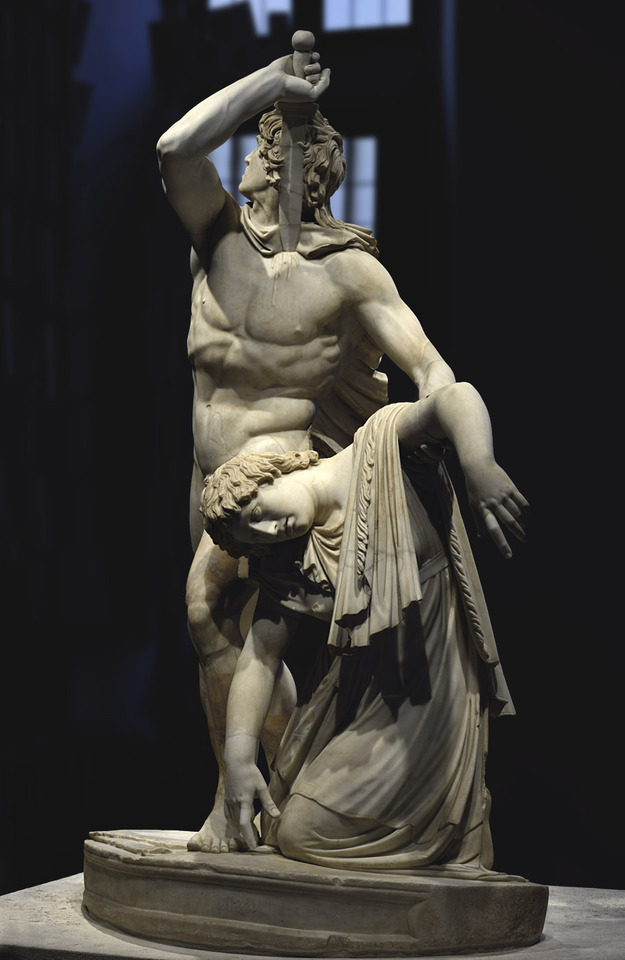
Epigonus (attributed) - Ludovisi Gaul Killing Himself and His Wife (2nd century C.E.)
0 notes
Photo

Primi igitur omnium statuuntur Epigonus et Eusebius ob nominum gentilitatem oppressi. praediximus enim Montium sub ipso vivendi termino his vocabulis appellatos fabricarum culpasse tribunos ut adminicula futurae molitioni pollicitos.
0 notes
Text
LATIN
Hae duae provinciae bello quondam piratico catervis mixtae praedonum a Servilio pro consule missae sub iugum factae sunt vectigales. et hae quidem regiones velut in prominenti terrarum lingua positae ob orbe eoo monte Amano disparantur.
Ex turba vero imae sortis et paupertinae in tabernis aliqui pernoctant vinariis, non nulli velariis umbraculorum theatralium latent, quae Campanam imitatus lasciviam Catulus in aedilitate sua suspendit omnium primus; aut pugnaciter aleis certant turpi sono fragosis naribus introrsum reducto spiritu concrepantes; aut quod est studiorum omnium maximum ab ortu lucis ad vesperam sole fatiscunt vel pluviis, per minutias aurigarum equorumque praecipua vel delicta scrutantes.
Et eodem impetu Domitianum praecipitem per scalas itidem funibus constrinxerunt, eosque coniunctos per ampla spatia civitatis acri raptavere discursu. iamque artuum et membrorum divulsa conpage superscandentes corpora mortuorum ad ultimam truncata deformitatem velut exsaturati mox abiecerunt in flumen.
Haec ubi latius fama vulgasset missaeque relationes adsiduae Gallum Caesarem permovissent, quoniam magister equitum longius ea tempestate distinebatur, iussus comes orientis Nebridius contractis undique militaribus copiis ad eximendam periculo civitatem amplam et oportunam studio properabat ingenti, quo cognito abscessere latrones nulla re amplius memorabili gesta, dispersique ut solent avia montium petiere celsorum.
Et quia Montius inter dilancinantium manus spiritum efflaturus Epigonum et Eusebium nec professionem nec dignitatem ostendens aliquotiens increpabat, qui sint hi magna quaerebatur industria, et nequid intepesceret, Epigonus e Lycia philosophus ducitur et Eusebius ab Emissa Pittacas cognomento, concitatus orator, cum quaestor non hos sed tribunos fabricarum insimulasset promittentes armorum si novas res agitari conperissent.
Ergo ego senator inimicus, si ita vultis, homini, amicus esse, sicut semper fui, rei publicae debeo. Quid? si ipsas inimicitias, depono rei publicae causa, quis me tandem iure reprehendet, praesertim cum ego omnium meorum consiliorum atque factorum exempla semper ex summorum hominum consiliis atque factis mihi censuerim petenda.
Sed si ille hac tam eximia fortuna propter utilitatem rei publicae frui non properat, ut omnia illa conficiat, quid ego, senator, facere debeo, quem, etiamsi ille aliud vellet, rei publicae consulere oporteret?
Haec igitur lex in amicitia sanciatur, ut neque rogemus res turpes nec faciamus rogati. Turpis enim excusatio est et minime accipienda cum in ceteris peccatis, tum si quis contra rem publicam se amici causa fecisse fateatur. Etenim eo loco, Fanni et Scaevola, locati sumus ut nos longe prospicere oporteat futuros casus rei publicae. Deflexit iam aliquantum de spatio curriculoque consuetudo maiorum.
Itaque tum Scaevola cum in eam ipsam mentionem incidisset, exposuit nobis sermonem Laeli de amicitia habitum ab illo secum et cum altero genero, C. Fannio Marci filio, paucis diebus post mortem Africani. Eius disputationis sententias memoriae mandavi, quas hoc libro exposui arbitratu meo; quasi enim ipsos induxi loquentes, ne 'inquam' et 'inquit' saepius interponeretur, atque ut tamquam a praesentibus coram haberi sermo videretur.
Accenderat super his incitatum propositum ad nocendum aliqua mulier vilis, quae ad palatium ut poposcerat intromissa insidias ei latenter obtendi prodiderat a militibus obscurissimis. quam Constantina exultans ut in tuto iam locata mariti salute muneratam vehiculoque inpositam per regiae ianuas emisit in publicum, ut his inlecebris alios
0 notes